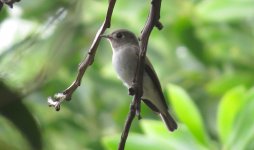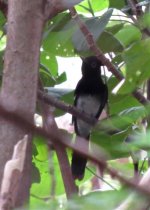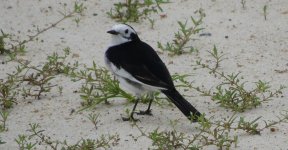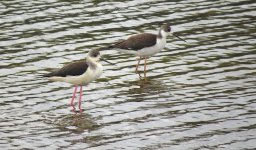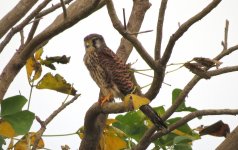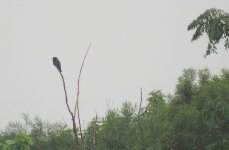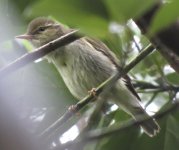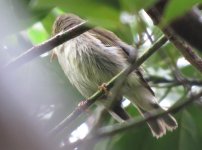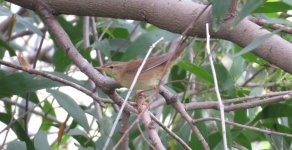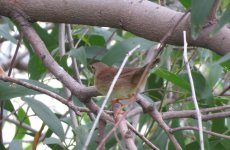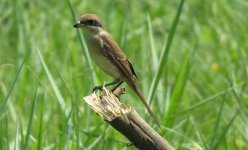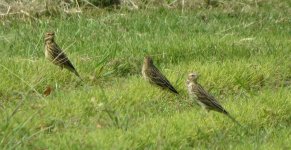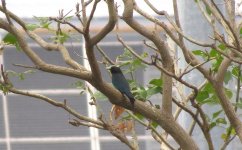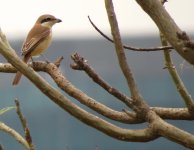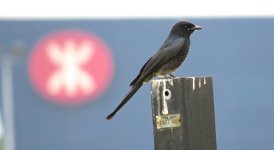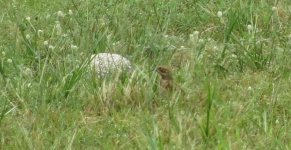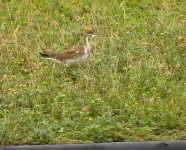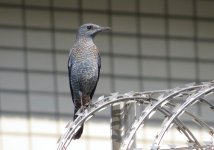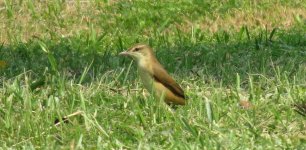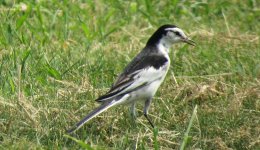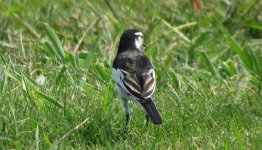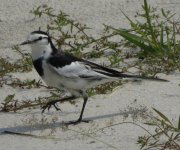As I would be away for the last four days of what has been an excellent month of autumn passage I went back to the Magic Roundabout on Sunday morning. In addition to being the final visit of the quarter it was also the last visit of my third reporting year (which runs from 1 October to 30 September) at the Roundabout.
The morning visit and the absence of the usual need to bird during the typically less productive midday heat meant that I could spend as long as I wanted in the cooler early morning hours.
It started well, with a Peregrine barreling west over the coach park. So steadily was it flying I even considered the possibility of a migrating Amur Falcon, albeit a rather early one, but the overall size and bulk of this, albeit a slimmer male bird, was just too distinctive.
Detouring round the taxi driver doing Tai Chi on the grassy verge in nothing but a pair of shorts that looked as tired as their occupier, I was pleased to find half a dozen White-shouldered Starlings exploring one of the twisty seed acacias on the Core Area for insects, as well as an a couple of Asian Brown Flycatchers chasing each other around the woods and an Arctic Warbler.
The Tangles were empty of all but the usual bulbuls and Magpie Robins, but a scolding call prompted me to check out a row of trees I rarely visit. I was rewarded with a Hair-crested Drongo that was amusing itself by bothering a group of Crested Mynas and Crested Bulbuls. The miscreant showed again on the Northern Edge, where I also added two more Asian Brown Flycatchers.
Moving on, another White-shouldered Starling flew up from the northwest corner of the golf course and ,as I headed down the grassy verge, I was pleased to flush my first Lanceolated Warbler of the autumn, which dived through the fence, then a Brown Shrike, and some fifty metres on, three different Pallas’ s Grasshopper Warblers, only one of which showed much of a hint of contrasting rufous on the rump. A fourth individual that flew out of one of the tussocks on the golf course unaccountably landed in plain sight on the short grass and even posed for a couple of photos before more typically de-materialising as I walked over to check it out. A Yellow-browed Warbler, looking distinctively dainty after all the Arctic Warblers I’ve been seeing this autumn, was also my first of the autumn.
As I came to the larger trees a very dark-looking flycatcher with a contrasting white belly flew up and hid itself in the foliage. I have been fooled in the past by recently washed bulbuls and Magpie Robins, but as it flipped again I was delighted to have wonderful views of a beautiful, long-awaited, Japanese Paradise Flycatcher (149), complete with a large blue eyering, black head and breast and just a hint of a maroon wash to the wings. In the past I’ve wondered whether some of the darker-looking Asian Paradise Flycatchers I’ve seen might have been Japanese, but having seen this morning’s bird, there’s no doubt the others were Asian Paras.
The golf course was a real pleasure, starting with just my second Stejneger’s Stonechat of the autumn and two of the four Red Turtle Doves that have been in residence for a couple of weeks now. A group of eight Richard’s Pipits and five or six taivana Yellow Wagtails were on the short turf, and a couple of Zitting Cisticolas were again in the taller grass by the edge of the long pond. Six Cattle Egrets also seemed to enjoy the rougher grass over the short-cropped fairways, and a Black Drongo swooped past, flared its tail in the drongo version of a handbrake turn, and swooped away.
The trees along the eastern edge, which I don’t usually have time to explore, produced my sixth and final new bird for the quarter – a couple of Dusky Warblers takking away in the undergrowth. I also saw and heard a couple of Yellow-bellied Prinias and two of juvenile Black-crowned Night Herons that have been loafing here for the last few weeks.
The ponds were a little quieter. The Black-winged Stilt contingent had increased to two birds, but the only other waders were a Common Sandpiper and a Little Ringed Plover. A nice final run of birds as I headed out included an Oriental Reed Warbler that dived into a lantana, but was too curious to stay hidden, four flyover Barn Swallows, my handsome old friend the leucopsis x alboides White Wagtail, single Little and Great Egrets and a Chinese Pond Heron flying over, two Brown Shrikes squabbling in the trees in the centre of the fairway, where they disturbed the pandoo Blue Rock Thrush, and the well established pair of White-throated Kingfishers.
Stop press:
I turn my back for one minute and two different birders find a Styan’s Grasshopper Warbler (also photographed) and a possible examinandus Arctic Warbler on Monday. Both of these are quality birds of the type I’ve done everything o earn in the last few weeks, and then not one but two Johnny-come-latelies swoop in and grip me in the most disgraceful and exasperating manner!
I finished the quarter with an impressive 75 species – my second-highest score behind the 82 I managed back in Oct-Dec 2014, and an average for the year of 64.5 species per quarter – comfortably more that the 58 from last year and 45.25 of my first year. The good score is in part attributable to having access to a golfer-free and much less disturbed golf course since the end of August, where before I had to peer into it from the viaduct at the northwest corner. Having said that, many of the quality birds have come from the western verge, which is outside the boundary fence.
Highlights of a year that, except for a disappointing Spring (April – June) has been birdy without producing a significant rarity include:
• the Hoopoe I found injured and brought up to my office to recover, and which happily is now well on the way to recovery at Kadoorie Farm’s excellent Wild Animal Rescue Centre.
• The mini passages of Daurian Starlings in late August/early September (including the earliest ever autumn record for Hong Kong), and falls of Blue Rock Thrushes and Pallas’s Grasshopper Warblers later this month
• The completely unexpected discovery of a Great Crested Grebe in the bay near the filling station in March
• The steady flow of additions to the list included Buff-bellied and Pechora Pipits, Northern Lapwing, Woodcock, Verditer Flycatcher, Red-billed Blue Magpie, and Fork-tailed Sunbird
• Three record-breaking days – 10 January: 39 species, 25 September: 40 species and 27 September: 43 species
• The sudden and welcome appearance of Chinese Skinks, where previously all herps have been conspicuous by their absence. I also had three Asian Painted Frogs calling at the golf course after rain earlier in the week.
The obvious targets for the next quarter are:
• to bring the patch list over 150. It’s worth remembering that that the current total of 149 includes a number of distinct races – three Yellow and four White wagtails and two Blue Rock Thrushes) and species which are generally unidentifiable in the field (Sakhalin/Pale-legged Leaf Warbler, the Arctic Warbler complex, and Swinhoe’s/Pintail Snipe),
• to see 50-species in a day.
• finding a few more Class A rarities!
Cheers
Mike

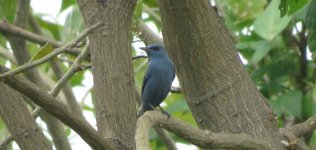 IMG_3491 Pandoo Blue Rock Thrush @ RDBT.JPG380.5 KB · Views: 203
IMG_3491 Pandoo Blue Rock Thrush @ RDBT.JPG380.5 KB · Views: 203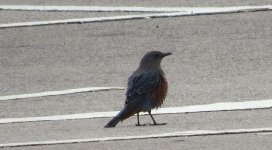 IMG_3510 - philippensis Blue Rock Thrush @ RDBT.JPG434.1 KB · Views: 86
IMG_3510 - philippensis Blue Rock Thrush @ RDBT.JPG434.1 KB · Views: 86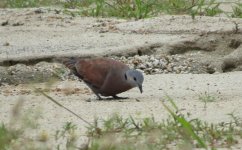 IMG_3493 Red Turtle Dove @ RDBT.JPG514.3 KB · Views: 78
IMG_3493 Red Turtle Dove @ RDBT.JPG514.3 KB · Views: 78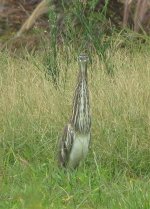 IMG_3502 - Chinese Pond Heron @ RDBT.jpg211.3 KB · Views: 108
IMG_3502 - Chinese Pond Heron @ RDBT.jpg211.3 KB · Views: 108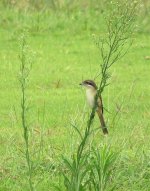 IMG_3483 Brown Shrike @ RDBT.jpg199.3 KB · Views: 95
IMG_3483 Brown Shrike @ RDBT.jpg199.3 KB · Views: 95




